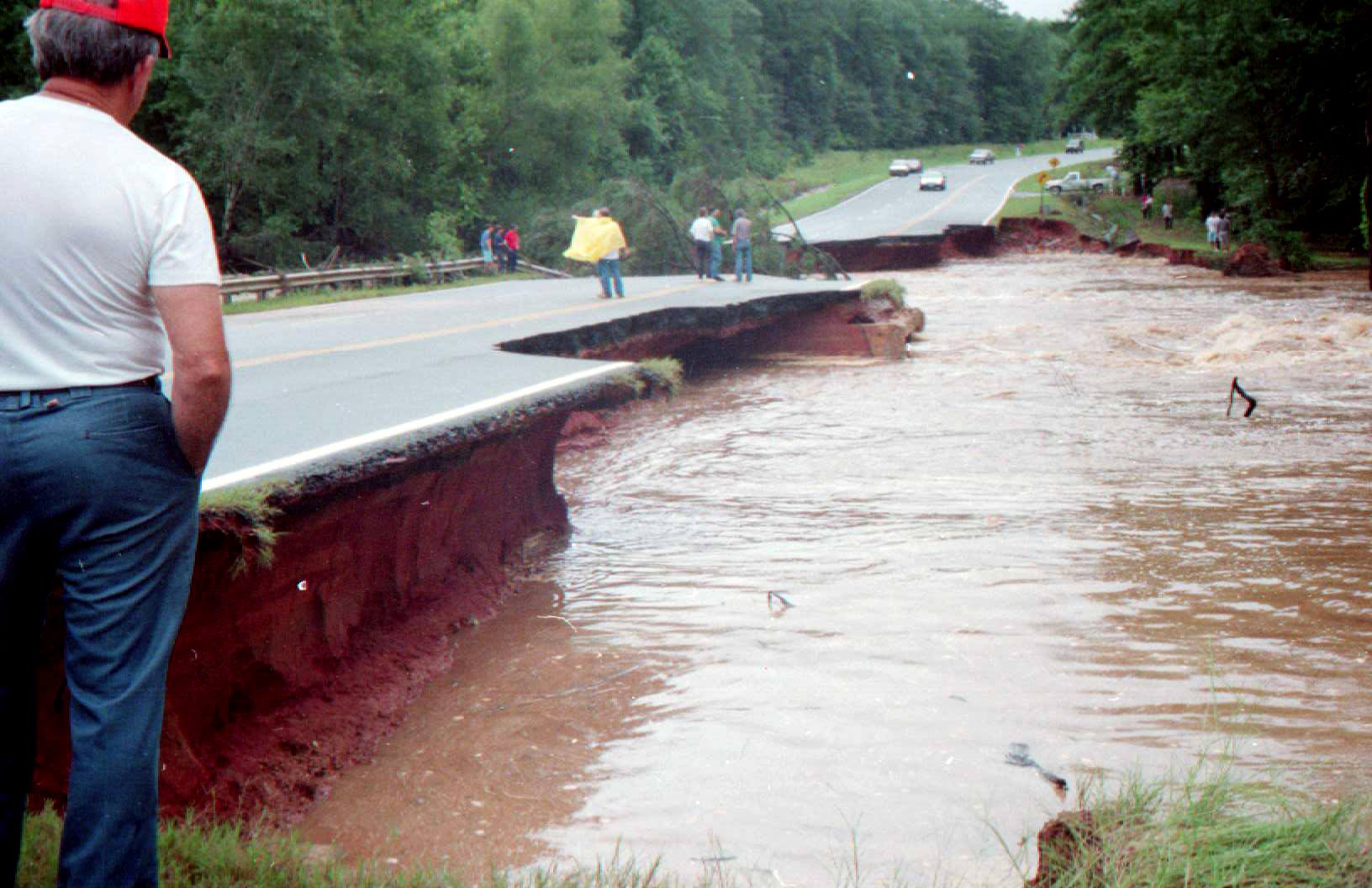!['94 Floods[ID=12433187] ID=12433187](http://www.gannett-cdn.com/-mm-/3c4ba25bc314276f787618462cb932e5c745d55c/r=500x323/local/-/media/WMAZ/WMAZ/2014/07/09/1404946654000-americus1.jpg) It was the worst natural disaster in Georgia's history.
It was the worst natural disaster in Georgia's history.
On July 3, 1994, Tropical Storm Alberto hit the Florida panhandle with winds of about 60 miles per hour.
A cold front pushing east from Alabama joined the storm and caused prolonged thunderstorms.
Many people in Central Georgia saw their July 4th celebrations rained out as the storm crawled across the state, dumping upwards of 12 inches of rain in a 24-hour period.
When they woke up on Tuesday, July 5th, they found the Ocmulgee River and its connecting tributaries rapidly rising and threatening homes and stranding travelers.
This is a look back at the Flood of '94 and the impact it left on Central Georgia.
![Remembering the Flood of '94[ID=12200473] ID=12200473](http://bcdownload.gannett.edgesuite.net/wmaz/34300057001/201407/3282/34300057001_3658079412001_th-53b5eee9e4b04d4f1eff6c40-1592194024001.jpg?pubId=34300057001)
Bob Fountain was the Bibb County engineer at the time of the flood. He was in charge of the bridges and roads of this throughout the area as well as being the levee superintendent.
Thinking back 20 years, Fountain says it was like something from a movie.
"It was like something from Star Wars," he said.
Their first action was to put sandbags anywhere they could. However, Fountain says there wasn't much they could do.
"We couldn't dump our garbage, couldn't flush your commode, couldn't brush your teeth, couldn't wash your hair," Fountain recalled.
![Remembering the Flood of '94[ID=12230785] ID=12230785](http://bcdownload.gannett.edgesuite.net/wmaz/34300057001/201407/2499/34300057001_3659528170001_thumbnail-for-video-3659401137001.jpg?pubId=34300057001)
Fountain's wife, Patsy, had a similar reaction.
"I couldn't believe it," Patsy Fountain recalled. "You know it happens all over the U.S. but not in Macon, Georgia. "I was just amazed."
![Remembering the Flood of '94[ID=12188689] ID=12188689](http://www.gannett-cdn.com/-mm-/33d97f8a03d5ea06baca0f7a30eca34c8bd87643/r=500x281/local/-/media/WMAZ/WMAZ/2014/07/03/1404423433002-floodaerial.jpg) Patsy Fountain remembers the water reaching above her waist. "We went out to Tobesofkee to see the flood gates and I'd just had never seen the water that angry," she said.
Patsy Fountain remembers the water reaching above her waist. "We went out to Tobesofkee to see the flood gates and I'd just had never seen the water that angry," she said.
The flood required improvisation for people to daily things often taken for granted.
"My sons rigged up a shower on our patio by using a ladder, an igloo cooler, and for my privacy, they put a tarp around it. That was our shower," Patsy Fountain said.
Bob Fountain said there were some positive outcomes to the flood, including a new water and sewer plant.
He also recalled a strong sense of community throughout the chaos.
"At times, it was a great feeling because we all were in the same boat together," he said. "You don't realize the power of water and sewer until you don't have it."
Former Bibb EMA director recalls the flood
The Ocmulgee River looks calm right now, far different than it did during the 1994 flood. It happened just 14 months after Johnny Wingers became the Macon-Bibb Emergency Management Agency director.
Wingers said he knew the situation was serious when the water plant went under and around 150,000 people were without drinking water.
"FEMA was bringing bottled water in. We set up 26 distribution points around, all around Macon. And the firemen, all of them at the fire stations, people outside holding water out, people drive by and pick up a gallon of water," said Wingers.
![Former Bibb EMA director recalls '94 flood[ID=12253441] ID=12253441](http://bcdownload.gannett.edgesuite.net/wmaz/34300057001/201407/3139/34300057001_3660445014001_th-53b86057e4b04d4f1effb233-782203287001.jpg?pubId=34300057001)
He said military troops were called in to help and were purifying water. Maconites pitched in too. One woman told Wingers she couldn't read or write, but wanted to contribute.
"She says I've always used my hands. So I put her on the job helping, using her hands, but not out there on the water, and that lady, I can still see her right now today," said Wingers.
He recalls lots of debris, even a home, floating down the Ocmulgee.
He said two people got caught in the river and died. That was his biggest fear realized. Crews were trying to keep people out of the water.
The rescue effort
Over the past Independence Day weekend, people were safely enjoying the Ocmulgee River in the shadow of the Spring Street bridge.
It was a much different story in July 1994.
The Ocmulgee reached 35 feet July 7th - that's more than twice the 17 feet flood level.
Even through the devastation.. people were fascinated by the raging waters.
"There were two fatalities in Bibb County, we got charged with two," says Johnny Wingers.
Then Bibb County Emergency Management Director Johnny Wingers remembered what happened.
"These people went into the area over there at Rocky Creek and Pio Nono, and they got caught up into it and it just pulled them right in there, and unfortunately, we lost two," says Wingers.
Search and rescue recovered a woman's body first, and the next day, a man.
There was also a dramatic rescue that unfolded live during our Midday news.
Liz Fabian, then Liz Jarvis, was on the scene.
![Remember the Flood of '94: The rescue effort[ID=12364515] ID=12364515](http://bcdownload.gannett.edgesuite.net/wmaz/34300057001/201407/2924/34300057001_3664607789001_th-53bc2587e4b0e5b1df7f211f-782203300001.jpg?pubId=34300057001)
The Macon-Bibb Fire Rescue boat with 3 men on board went under the bridge.
Macon police and fire were right there and sprang into action.
"I didn't really want to believe it at first, but as I got onto the bridge, I seen them, and my heart started pumping harder. And I didn't know how we were going to get them out," says one Macon police officer.
The men were able to grab onto trees on the opposite bank and were ultimately rescued.
Floods of '94 lead to infrastructure improvements
At the time of the floods of 1994, the Macon Water Authority was already looking to expand its Pierce Ave. facility a little upstream next to the Ocmulgee River.
Instead, the flood reached both the treatment plant and the newer site, with water reaching 317 feet above sea level.
"It flooded that piece of property that the improvements or the additions were going on and it was obvious when that occurred that the location was not a location for the plant," explains MWA President Tony Rojas.
![Flood of '94 leads to infrastructure improvements[ID=12385683] ID=12385683](http://bcdownload.gannett.edgesuite.net/wmaz/34300057001/201407/2100/34300057001_3665076525001_th-53bc768ae4b0efcf98b8df5c-672293882001.jpg?pubId=34300057001)
The flood prompted the MWA to move their facility to Javors Lucas Lake in Jones County, at a much higher elevation. The plant opened in 2000, almost six years after the flood.
The flood also had an impact in smaller counties like Monroe, where two wooden bridges, including Flat Bridge on Mayfield Road were completely destroyed by the floods.
Retired Monroe County Roads Superintendent Sid Banks says the flood proved to be a blessing in disguise because it allowed to county to get funds to replaced outdated wooden bridges and dirt roads with concrete and paved roads.
He says the bridges are also slightly higher in elevation.
Americus remembers the flood
On July 5th, 1994, the small South Georgia city of Americus was caught by surprise.
Rains came in suddenly, dropping 24 inches in a day according to the Centers for Disease Control
By nighttime, roads quickly disappeared.
![Americus remembers 1994 flood[ID=12432221] ID=12432221](http://bcdownload.gannett.edgesuite.net/wmaz/34300057001/201407/68/34300057001_3666923811001_th-53bdc0a3e4b01417b972a92c-1592194027001.jpg?pubId=34300057001)
"They called me in and I came into town on Highway 30. Highway 30 was there, 30 minutes later a dam had busted, highway 30 wasn't there," says fire marshal Zane Newman.
While the downtown was spared, the quick rains impacted some of the main roads into the city and creeks expanded, catching drivers off guard.
"Some of them were driving and they just didn't know the road, and they were just gone, they went right through it and just washed away.," says chief Allen Erkhart.
Crews came together to do everything possible to rescue people caught in the water, even taking equipment from a local construction company to reach them.
![Flood of '94, Americus[ID=12421637] ID=12421637](http://www.gannett-cdn.com/-mm-/b7c3aa85ab87444e36c344849ece80bda428b251/c=114-0-1518-1054&r=115x86/local/-/media/WMAZ/WMAZ/2014/07/09/1404935926003-flood3.jpg)
In the end, 15 people were killed in Sumter County, more than anywhere else in the state.
The CDC says the cause of around half of those were from ruptured dams spilling into creeks.
The floods were the largest natural disaster in Georgia history.


